Subject 2. Preparing the Cash Flow Statement
#has-images
The beginning and ending cash balances on the statement of cash flows tie directly to the Cash and Cash Equivalents accounts listed on the balance sheets at the beginning and end of the accounting period.
Net income differs from net operating cash flows for several reasons.
- One reason is non-cash expenses, such as depreciation and the amortization of intangible assets. These expenses, which require no cash outlays, reduce net income but do not affect net cash flows.
- Another reason is the many timing differences existing between the recognition of revenue and expense and the occurrence of the underlying cash flows.
- Finally, non-operating gains and losses enter into the determination of net income, but the related cash flows are classified as investing or financing activities, not operating activities.
There are two methods of converting the income statement from an accrual basis to a cash basis. Companies can use either the direct or the indirect method for reporting their operating cash flow.
- The direct method discloses operating cash inflows by source (e.g., cash received from customers, cash received from investment income) and operating cash outflows by use (e.g., cash paid to suppliers, cash paid for interest) in the operating activities section of the cash flow statement.
- It adjusts each item in the income statement to its cash equivalent.
- It shows operating cash receipts and payments. More cash flow information can be obtained and it is more easily understood by the average reader.
- The indirect method reconciles net income to net cash flow from operating activities by adjusting net income for all non-cash items and the net changes in the operating working capital accounts.
- It shows why net income and operating cash flows differ.
- It is used by most companies.
- The direct and indirect methods are alternative formats for reporting net cash flows from operating activities. Both methods produce the same net figure (dollar amount of operating cash flow).
- Under IFRS and U.S. GAAP, both the direct and indirect methods are acceptable for financial reporting purposes. However, the direct method discloses more information about a company. Partly because companies want to limit information disclosed, the indirect method is more commonly used.
- The reporting of investing and financing activities is the same for both direct and indirect methods. Only the reporting of CFO is different.
Direct Method
Under the direct method, the statement of cash flows reports net cash flows from operations as major classes of operating cash receipts and cash disbursements. This method converts each item on the income statement to its cash equivalent. The net cash flows from operations are determined by the difference between cash receipts and cash disbursements.
Assume that Bismark Company has the following balance sheet and income statement information:
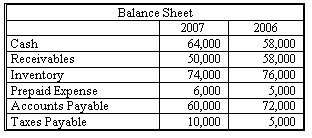
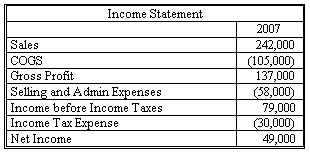
Additional information:
- Receivables relate to sales and accounts payable relates to cost of goods sold.
- Depreciation of $5,000 and pre-paid expense both relate to selling and administrative expenses.
Direct Method:
- Cash sales: sales on the accrual basis are $242,000. Since the receivables have decreased by $8,000, the cash collections are higher than accrual-basis sales.
Sales: $242,000
Add decrease in receivables: $8,000
Cash sales: $250,000 - Cash purchases: since inventory decreased by $2,000, goods purchased in prior years were used as the cost of goods sold. Since accounts payable decreased by $12,000, more cash was paid in 2000 for goods than is reported under accrual accounting.
Costs of goods sold: $105,000
Deduct decrease in inventories: $2,000
Add decrease in accounts payable: $12,000
Cash purchases: $115,000 - Cash selling and administrative expenses: the selling and administrative expenses include a non-cash charge of $5,000 related to depreciation. In addition, pre-paid expenses (assets) increased by $1,000 and should be added to the selling and administrative expenses.
Selling and administrative expenses: $58,000
Deduct depreciation expense: $5,000
Add increase in pre-paid expense: $1,000
Cash selling and administrative expenses: $54,000 - Cash income taxes: income tax on the accrual basis is $30,000. Tax payable, however, has increased by $5,000. This means a portion of the taxes has not been paid. As a result:
Income tax expense: $30,000
Deduct increase in taxes payable: $5,000
Income tax paid: $25,000
The presentation of the direct method for reporting net cash flow from operating activities:
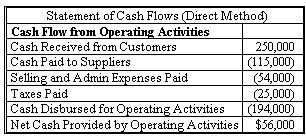
Indirect Method
The indirect method uses net income (as reported in the income statement) as the starting point in the computation of net cash flows from operating activities. Adjustments to net income necessary to arrive at net cash flows from operating activities fall into three categories: non-cash expenses, timing differences, and non-operating gains and losses. Adjustments reconcile net income (accrual basis) to net cash flows from operating activities. In other words, the indirect method adjusts net income for items that affected reported net income but did not affect cash.
The four-step process:
1. Start with net income.
2. Add back non-cash charges such as depreciation and amortization of intangibles. Cash payments for long-lived assets such as plants and intangibles occur when they are purchased. Purchase of these assets is reflected as an investing activity at that time. When depreciation expense is recognized in the current period, it simply indicates the paper allocation of original purchase cost to this period. As a result, expenses increase without a corresponding cash outlay. Since depreciation does not affect cash flow, it should be added back to net income to compute net CFO.
3. Add back losses and subtract gains from investing or financing activities. Examples include gains/losses from sale of property, plants and equipment (investing activity) or gains/losses from early retirement of debt (financing activity). Why? Disposal of fixed assets will be used to illustrate this. The gains and losses from the disposal of fixed assets appear on the income statement. However, disposal of fixed assets is an investing activity, so the entire cash receipt is shown as an investing cash inflow. Therefore, the gains or losses should be removed from net income so as to prevent double-counting cash flows. Note that it is the proceeds from disposal, not the gain or loss, that constitute the cash flow.
4. Adjust for changes in operating related accounts (current assets and current liabilities other than cash, short-term borrowings, and short-term investments). For example, an increase in current assets ties up cash, thereby reducing operating cash flow. An increase in current liabilities postpones cash payments, thereby freeing up cash and increasing operating cash flows in the current period. An increase in assets reduces cash and should be deducted from net income. An increase in liabilities increases cash and should be added to net income.
Note that short-term investments are considered an investing activity and short-term borrowing is considered a financing activity.
Example
Selton Co.'s balance sheet and income statement are presented below.
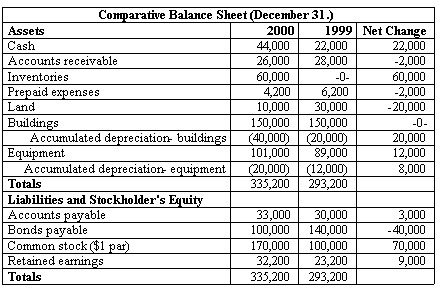
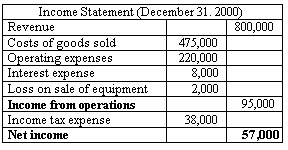
Additional information:
(a) Operating expenses include a depreciation expense of $34,000 and amortization of pre-paid expenses of $2,000.
(b) Land was sold at its book value for cash.
(c) A cash dividend of $48,000 was paid in 2000.
(d) An interest expense of $8,000 was paid in cash.
(e) Equipment with a cost of $36,000 was purchased for cash. Equipment with a cost of $24,000 and a book value of $18,000 was sold for $16,000 cash.
(f) Bonds were redeemed at their book value for cash.
(g) Common stock ($1 par value) was issued for cash.
Explanations of the adjustments to the net income of $57,000 are as follows:
a. Accounts receivable: The decrease of $2,000 should be added to net income to convert from the accrual basis to the cash basis.
b. Inventories: The increase of $60,000 represents an operating use of cash for which an expense was not incurred. This amount is therefore deducted from net income to arrive at cash flow from operations.
c. Pre-paid expense: The decrease of $2,000 represents a change to the income statement for which there was no cash outflow in the current period. The decrease should be added back to net income.
d. Accounts payable: When it increases, the cost of goods sold and the expense on a cash basis are lower than they are on an accrual basis. The increase of $3,000 should be added back to net income.
e. Depreciation expense: The depreciation expense for the building is $20,000. Due to the sale of equipment, the depreciation for equipment is (24,000 - 18,000) + 20,000 - 12,000 = $14,000. This amount plus $20,000 should be added back to net income to determine net cash flow from operating activities.
f. Loss on sale of equipment: The loss of $2,000 on sale of equipment should be added back to net income since the loss did not reduce cash (but it did reduce net income).
Cash flows from investing and financing activities:
a. Land: The sale of land for $20,000 is an investing cash inflow.
b. Equipment: The purchase of equipment for $36,000 is an investing cash outflow and the sale for $16,000 is an investing cash inflow.
c. Bonds payable: This financing activity used $40,000 cash.
d. Common stock: Common stock of $80,000 was issued as a financing cash inflow.
e. Retained earnings: The increase of $9,000 is the result of net income of $57,000 from operations and the financing activity of paying cash dividends of $48,000.
The statement of cash flows is prepared as follows:
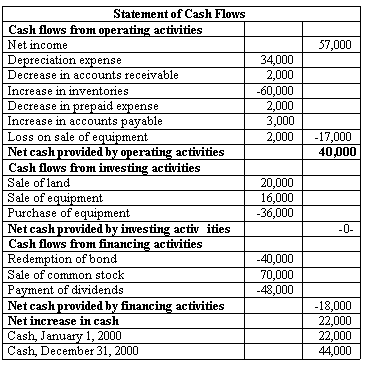
Conversion of Cash Flows from the Indirect to the Direct Method
Although the indirect method is most commonly used by companies, the analyst can generally convert it to the direct format by following a simple three-step process.
- Aggregate all revenue and all expenses.
- Remove all non-cash items from aggregated revenues and expenses and break out remaining items into relevant cash flow items.
- Convert accrual amounts to cash flow amounts by adjusting for working capital changes.